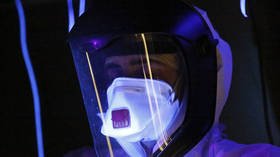The handheld high-intensity UV lamp that could KILL coronavirus once and for all

We may have a powerful new weapon in the war against Covid-19, as a scientific breakthrough has paved the way for personal, handheld devices that emit high-intensity ultraviolet (UV) light capable of killing the coronavirus.
Chemical or UV exposure are the most common methods of sanitizing and disinfecting surfaces from bacteria and viruses. In the latter case, there need to be sufficiently high levels of UV radiation – 200 to 300 nanometers – to kill the unwanted bugs.
Such devices do exist at present, but are prohibitively expensive, use discharge lamps that contain mercury, are bulky and short-lived, and require a large amount of power to function. Not exactly ideal for scaling up to rid the world of Covid-19.
Also on rt.com Game changer: German scientists find antibodies that BLOCK coronavirus from spreading furtherHowever, using theoretical modeling of a range of materials, researchers at Penn State, the University of Minnesota and two Japanese universities believe they have found the holy grail of transparent conductors, which could allow for cheap, easy-to-produce LEDs that emit UV light at a high enough intensity to kill coronavirus.
Which wavelengths of UV light are best for killing coronaviruses to disinfect surfaces? An interdisciplinary team of Penn State researchers has been awarded seed-grant funding to find out. https://t.co/PO5kT77OuNpic.twitter.com/UQA5uBi7f6
— Penn State (@penn_state) June 2, 2020
Computer, smartphone and lighting manufacturers have often grappled with finding transparent electrode materials that function in the visible light spectrum, let alone the ultraviolet spectrum. But the researchers have settled on a substance called strontium niobate as the potential game-changer material.
“While our first motivation in developing UV transparent conductors was to build an economic solution for water disinfection, we now realize that this breakthrough discovery potentially offers a solution to deactivate Covid-19 in aerosols that might be distributed in the HVAC (heating, ventilation and air conditioning) systems of buildings,” one of the researchers, Joseph Roth, a doctoral candidate in materials science and engineering at Penn State, explains.
Also on rt.com 17yo blood sample with SARS antibodies could be new secret weapon against CORONAVIRUS – studyThe researchers have secured $90,000 in seed funding to determine the ‘Goldilocks zone’ for UV intensity and exposure time to eradicate airborne viruses. This stage of testing will take place in a Biosafety Level 2 laboratory at Penn State University Park.
The team will then take their findings and run them against computational fluid dynamics modeling and lighting simulations to figure out how to take the customized UV emitters and apply them to different buildings’ ventilation systems to prevent coronavirus and other pathogens from spreading via the air we breathe and recirculating in our homes, businesses, offices and hospitals.
“This research may serve to expedite the return to shared building spaces like offices,” Penn State architectural engineering professor Sez Atamturktur said.
Think your friends would be interested? Share this story!















